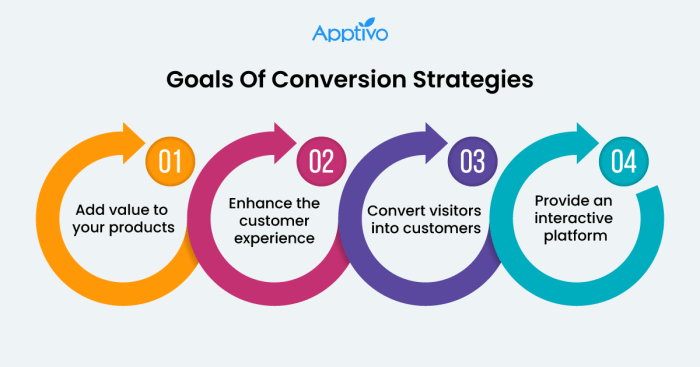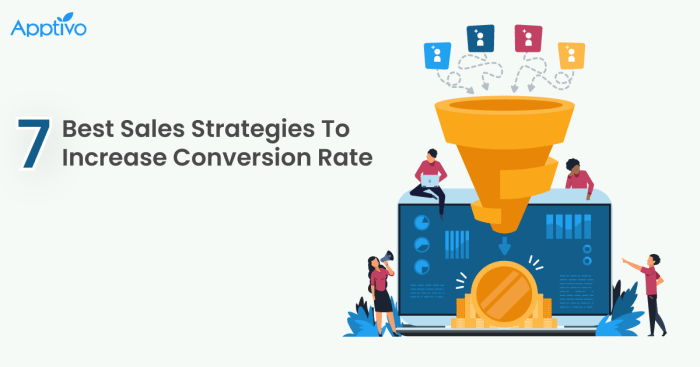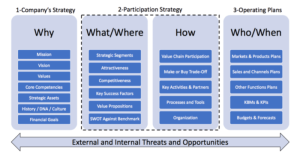
With Sales Strategy to Increase Conversions at the forefront, this paragraph opens a window to an amazing start and intrigue, inviting readers to embark on a storytelling filled with unexpected twists and insights.
Exploring successful strategies, personalization importance, and data analysis role in enhancing conversions sets the stage for a dynamic discussion.
Sales Strategy to Increase Conversions

Implementing effective sales strategies is crucial for businesses looking to boost their conversion rates and drive revenue growth. Let’s explore some successful strategies that have proven to increase conversions.
Personalization in Sales Strategies
Personalization plays a key role in sales strategies as it helps tailor the customer experience to meet individual needs and preferences. By customizing interactions and offerings based on customer data, businesses can significantly enhance conversion rates. For example, sending personalized product recommendations or targeted promotions based on past purchase behavior can lead to higher conversion rates and customer satisfaction.
Data Analysis for Effective Sales Strategies
Data analysis is essential for developing effective sales strategies that can drive conversions. By analyzing customer data, businesses can gain valuable insights into customer behavior, preferences, and trends. This data-driven approach allows businesses to identify areas for improvement, optimize sales processes, and target the right customers with the right offers at the right time. For instance, analyzing website traffic patterns and conversion funnels can help businesses streamline the customer journey and remove any bottlenecks that may be hindering conversions.
Sales Training
Sales training is a crucial aspect of ensuring the success of a sales team. Ongoing training helps sales professionals stay updated on industry trends, best practices, and new technologies, ultimately leading to increased conversions and revenue.
Importance of Ongoing Sales Training
- Keeps sales team motivated and engaged
- Improves product knowledge and understanding
- Enhances sales techniques and strategies
- Encourages continuous learning and skill development
Best Practices for Conducting Engaging Sales Training Sessions
- Utilize interactive techniques such as role-playing and group activities
- Provide real-life examples and case studies to make training relatable
- Encourage open communication and feedback during training sessions
- Offer opportunities for hands-on practice and application of new skills
Impact of Incorporating Technology in Sales Training Programs
Utilizing technology in sales training programs can have a significant impact on the effectiveness and efficiency of training sessions. Some benefits include:
“Enables virtual training sessions for remote teams”
“Provides access to online resources and e-learning modules for continuous learning”
“Allows for tracking and analyzing training data for better insights and improvements”
Elements of an Effective Sales Strategy
Effective sales strategies are crucial in improving conversion rates and driving business growth. These strategies should be carefully crafted to align with changing market dynamics and maximize impact. Let’s explore some key elements that should be included in a sales strategy to achieve these goals.
Understanding Target Audience
- Conduct thorough market research to identify the needs, preferences, and pain points of your target audience.
- Create buyer personas to tailor your sales approach and messaging to resonate with potential customers.
- Segment your audience based on demographics, behavior, and buying patterns to personalize your sales strategies.
Clear Value Proposition
- Clearly communicate the unique value your product or service offers to solve customer problems or meet their needs.
- Differentiate your offering from competitors by highlighting key benefits and advantages that set you apart in the market.
- Create compelling messaging that resonates with your target audience and emphasizes the benefits of choosing your solution.
Effective Sales Team Training
- Invest in ongoing training and development for your sales team to enhance their skills, product knowledge, and sales techniques.
- Equip your team with the tools and resources they need to effectively engage with prospects, address objections, and close deals.
- Foster a culture of continuous improvement and feedback to ensure your sales team is adaptive and responsive to changing market dynamics.
Utilizing Data and Analytics
- Utilize data and analytics to track key performance metrics, identify trends, and measure the effectiveness of your sales strategies.
- Implement a CRM system to organize customer data, streamline processes, and improve communication with leads and prospects.
- Use data-driven insights to optimize your sales processes, refine targeting strategies, and tailor your approach based on real-time feedback.
Implementing Sales Strategies

Implementing a new sales strategy to increase conversions requires careful planning and execution. Below are the steps involved in successfully implementing a sales strategy:
Step 1: Set Clear Objectives
- Define specific goals for the new sales strategy, such as increasing conversion rates, expanding customer base, or boosting sales revenue.
- Ensure that objectives are measurable and achievable within a set timeframe.
Step 2: Train Sales Team
- Provide comprehensive training to the sales team on the new strategy, including product knowledge, sales techniques, and customer communication.
- Ensure that the team understands the objectives and their roles in achieving them.
Step 3: Implement Technology Tools
- Utilize CRM systems, sales automation tools, and analytics software to track and analyze sales performance.
- Integrate these tools into the sales process to streamline operations and identify areas for improvement.
Step 4: Monitor Progress and Adjust
- Regularly review sales performance metrics to assess the effectiveness of the new strategy.
- Identify any challenges or bottlenecks in the sales process and make necessary adjustments to optimize results.
Common Challenges and Solutions
During the implementation of sales strategies, common challenges may arise, such as resistance from the sales team, lack of resources, or market changes. To overcome these challenges:
Provide ongoing support and training to the sales team to address any resistance and ensure alignment with the new strategy.
Allocate sufficient resources and budget for the implementation of the sales strategy to avoid setbacks or delays.
Stay agile and adaptable to market changes by continuously monitoring trends and adjusting the strategy accordingly.
Role of Feedback and Evaluation
Feedback and evaluation play a crucial role in refining and optimizing sales strategies. By gathering feedback from customers, sales team members, and stakeholders, you can:
- Identify areas for improvement and address customer concerns or preferences.
- Evaluate the effectiveness of the strategy in achieving set objectives and make data-driven decisions for optimization.
Summing up the significance of aligning sales strategies with market dynamics and the crucial role of feedback and evaluation in refining them.
Questions and Answers
What are some common challenges faced during the implementation of sales strategies?
Common challenges include resistance from team members, lack of resources, and difficulties in adapting to new processes. Overcoming them requires clear communication, training, and leadership support.
How can sales strategies be aligned with changing market dynamics?
To align strategies with market dynamics, businesses should regularly analyze market trends, customer preferences, and competitor actions. Flexibility, quick adaptation, and continuous learning are key to staying ahead.






